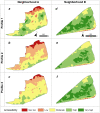Assessing and Qualifying Neighborhood Walkability for Older Adults: Construction and Initial Testing of a Multivariate Spatial Accessibility Model
- PMID: 35162830
- PMCID: PMC8834981
- DOI: 10.3390/ijerph19031808
Assessing and Qualifying Neighborhood Walkability for Older Adults: Construction and Initial Testing of a Multivariate Spatial Accessibility Model
Abstract
Population aging and urban development pose major challenges for societies today. Joining the literature assessing urban accessibility, the present exploratory research developed a multivariate accessibility model based on four independent variables-related to formal and structural urban space-that influence walkability for older adults (pedestrian network; facilities and shops; public benches; and slopes and gradients). The model used ArcGIS software. For the accessibility calculations, we selected two suburban neighborhoods in the conurbation of Grenoble (France) and selected three types of older adults' profiles to reflect the variety of aging: an older adult in good health, an older adult with a chronic disease, and an older adult with reduced mobility. The results suggest that the accessibility of a neighborhood depends not only on its physical and urban characteristics, but it is also influenced by the physical and health characteristics of its inhabitants. The originality of the model lies mainly in its ability to estimate the spatial accessibility of a territory by taking into account, firstly, objective data such as the physical characteristics and the built environment of the neighborhood through objectification variables that consider such original variables as the presence of benches or the slopes and gradients and, secondly, specific data such as the physical and/or health characteristics of the study population. The measurement of geospatial accessibility could be of great value for public health in urban contexts, which is why relevant tools and methodologies are needed to objectively examine and intervene in public spaces in order to make them age-friendly.
Keywords: accessibility; geographic information systems; older adults; spatial accessibility model; walking.
Conflict of interest statement
The authors declare no competing interest.
Figures





Similar articles
-
Relationship between neighborhood walkability and older adults' physical activity: results from the Belgian Environmental Physical Activity Study in Seniors (BEPAS Seniors).Int J Behav Nutr Phys Act. 2014 Aug 23;11:110. doi: 10.1186/s12966-014-0110-3. Int J Behav Nutr Phys Act. 2014. PMID: 25148845 Free PMC article.
-
The associations between objectively-determined and self-reported urban form characteristics and neighborhood-based walking in adults.Int J Behav Nutr Phys Act. 2014 Jun 4;11:71. doi: 10.1186/1479-5868-11-71. Int J Behav Nutr Phys Act. 2014. PMID: 24893719 Free PMC article.
-
Walking-friendly built environments and objectively measured physical function in older adults.J Sport Health Sci. 2020 Dec;9(6):651-656. doi: 10.1016/j.jshs.2020.02.002. Epub 2020 Feb 7. J Sport Health Sci. 2020. PMID: 33308816 Free PMC article.
-
Associations between the built environment and physical activity in children, adults and older people: A narrative review of reviews.Prev Med. 2024 Mar;180:107856. doi: 10.1016/j.ypmed.2024.107856. Epub 2024 Jan 12. Prev Med. 2024. PMID: 38220061 Review.
-
Effects of neighborhood built environment on cognitive function in older adults: a systematic review.BMC Geriatr. 2024 Feb 27;24(1):194. doi: 10.1186/s12877-024-04776-x. BMC Geriatr. 2024. PMID: 38408919 Free PMC article.
Cited by
-
Opportunities and shortcomings of AI for spatial epidemiology and health disparities research on aging and the life course.Health Place. 2024 Sep;89:103323. doi: 10.1016/j.healthplace.2024.103323. Epub 2024 Jul 23. Health Place. 2024. PMID: 39047648
-
The Effects of Pedestrian Environment on Ambulation with a Walking Frame in Elderly Individuals: A Survey and Experimental Study.Int J Environ Res Public Health. 2022 Jul 30;19(15):9327. doi: 10.3390/ijerph19159327. Int J Environ Res Public Health. 2022. PMID: 35954684 Free PMC article.
-
Systematic and meta-based evaluation of the relationship between the built environment and physical activity behaviors among older adults.PeerJ. 2023 Sep 25;11:e16173. doi: 10.7717/peerj.16173. eCollection 2023. PeerJ. 2023. PMID: 37780389 Free PMC article.
References
-
- United Nations World Population Prospects—Population Division—United Nations; Department of Economic and Social Affairs. 2019. [(accessed on 12 November 2020)]. Available online: https://population.un.org/wpp/
-
- Lord S., Piché D. Vieillissement et Aménagement: Perspectives Plurielles. Les Presses de l’Université de Montréal; Montreal, QC, Canada: 2018.
-
- Buffel T., Phillipson C., Scharf T. Ageing in Urban Environments: Developing “age-Friendly” Cities. Crit. Soc. Policy. 2012;32:597–617. doi: 10.1177/0261018311430457. - DOI
-
- Bonaccorsi G., Manzi F., Del Riccio M., Setola N., Naldi E., Milani C., Giorgetti D., Dellisanti C., Lorini C. Impact of the Built Environment and the Neighborhood in Promoting the Physical Activity and the Healthy Aging in Older People: An Umbrella Review. Int. J. Environ. Res. Public Health. 2020;17:6127. doi: 10.3390/ijerph17176127. - DOI - PMC - PubMed
-
- Van Cauwenberg J., Nathan A., Barnett A., Barnett D.W., Cerin E., Council on Environment and Physical Activity (CEPA)-Older Adults Working Group Relationships Between Neighbourhood Physical Environmental Attributes and Older Adults’ Leisure-Time Physical Activity: A Systematic Review and Meta-Analysis. Sports Med. 2018;48:1635–1660. doi: 10.1007/s40279-018-0917-1. - DOI - PubMed
Publication types
MeSH terms
LinkOut - more resources
Full Text Sources

